Star Cinema History
Stayton Theatre
(circa 1913)
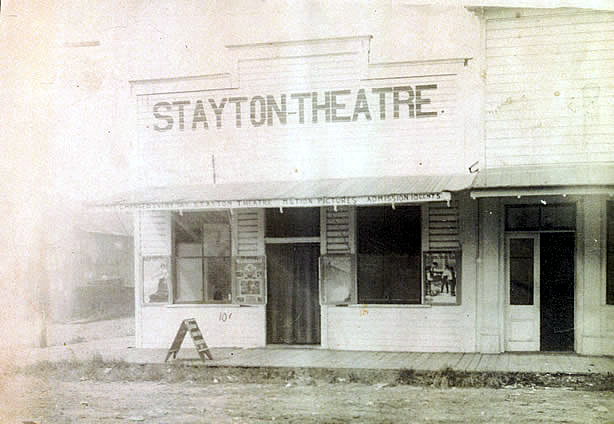
Above is a photo of the Stayton Theatre around 1913,
which was located off of 2nd and E. Water St. near the automotive
area of downtown Stayton of today. The photo's below are from the
1913 Stayton Mail Newspaper. In addition to showing motion pictures,
live entertainment was offered almost weekly. You could come to
the Stayton Theatre and enjoy singers, dancers, musicians and
all
sorts of theatrical entertainment from all over the United States.
The Stayton Theatre eventually moved to the Oddfellow building
and
was renamed Star Theatre. That theatre closed down just after the
Star Theater opened where the Police Station is now located. 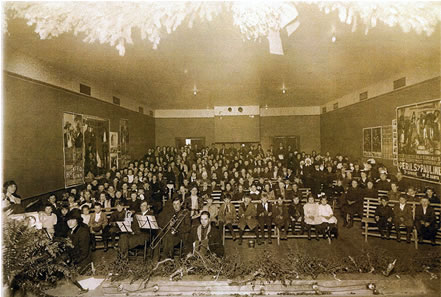 The
photo on the left is from Opening Day Ceremonies at the New Star
Theater in 1914, where the Oddfellow is located. Click image for
larger view. The days of "The Perils of Pauline" and
other oldies. Boughs of evergreens, barely visible above, show
the festive
occasion as a small band and pianist, lower left, accompany screen
images. Genevieve Lawrence is one of the local residents who
remember
the old movie days - she accompanied the moods of screen stars
on her old upright, earning about $1 an evening in the early
1920's.
She never took a lesson and played completely by ear such tunes
as the Maple Leaf Rag and the Burning of Rome. For 25 cents
you
could watch Rudolph Valentino or Abbot and Costello. Then between
1919 and 1922, the new Star Theatre opened where the current
Police
station is today. Frank Lesley built the theatre and Ed Keech ran
the movie house then; and in 1937 Lawrence and Mae Spraker bought
the Star from George and Edwin Keech.
Spraker
took
on
a
partner in 1946,
Marcel VanDreische. In 1949, the New Star Cinema of today was opened
and Spraker concentrated on the Stayton Mail Newspaper while
Marcel
took full ownership of the theatre.
The
photo on the left is from Opening Day Ceremonies at the New Star
Theater in 1914, where the Oddfellow is located. Click image for
larger view. The days of "The Perils of Pauline" and
other oldies. Boughs of evergreens, barely visible above, show
the festive
occasion as a small band and pianist, lower left, accompany screen
images. Genevieve Lawrence is one of the local residents who
remember
the old movie days - she accompanied the moods of screen stars
on her old upright, earning about $1 an evening in the early
1920's.
She never took a lesson and played completely by ear such tunes
as the Maple Leaf Rag and the Burning of Rome. For 25 cents
you
could watch Rudolph Valentino or Abbot and Costello. Then between
1919 and 1922, the new Star Theatre opened where the current
Police
station is today. Frank Lesley built the theatre and Ed Keech ran
the movie house then; and in 1937 Lawrence and Mae Spraker bought
the Star from George and Edwin Keech.
Spraker
took
on
a
partner in 1946,
Marcel VanDreische. In 1949, the New Star Cinema of today was opened
and Spraker concentrated on the Stayton Mail Newspaper while
Marcel
took full ownership of the theatre.
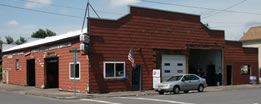 |
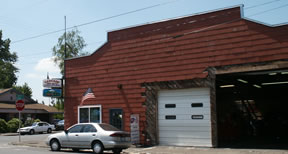 |
Stayton Theatre
Today (Automotive Repair) |
Stayton Theatre
Today (Automotive Repair) |
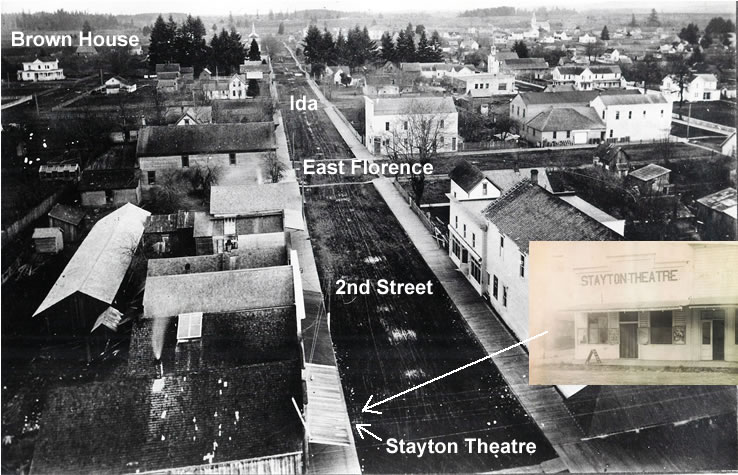
| Frank Lesley, owner of the Stayton Hotel, built the Stayton Theatre in 1912 and leased it for a year to Ted Rizzo at his first location in the old store front on 2nd street. At the end of the lease, Rizzo moved his operation into part of the Oddfellow building and a Mill City man named Wadsworth took over the Lesley theatre for six months. It was he who named it the Star. At the end of six months Wadsworth pulled out and Lesley's 18 year old son, Oliver, managed the Star for about two years after which it was leased to half a dozen different people and finally sold in 1919 to Harry Humphries who, in turn, sold to George Keech in 1926. Keech installed the first sound projectors and he and his son, Ed, operated the theatre until selling it to Lawrence Spraker in 1937. |
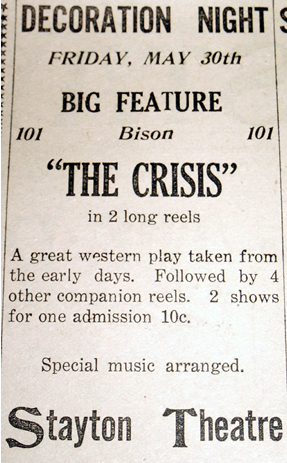 |
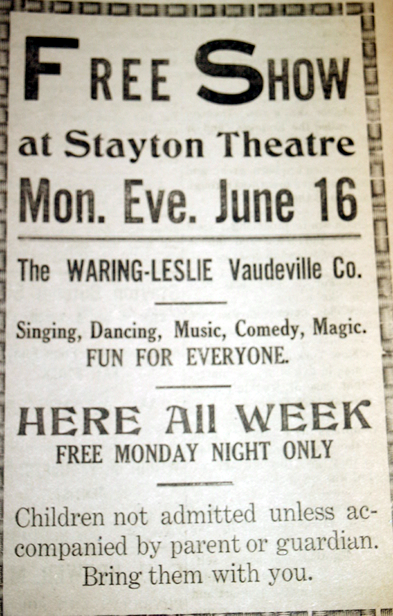 |
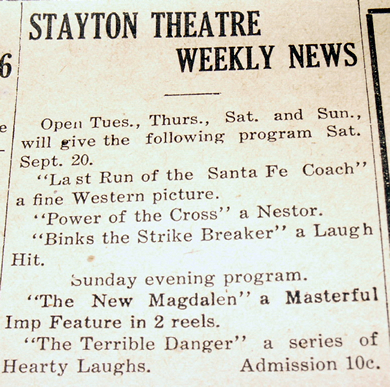 |
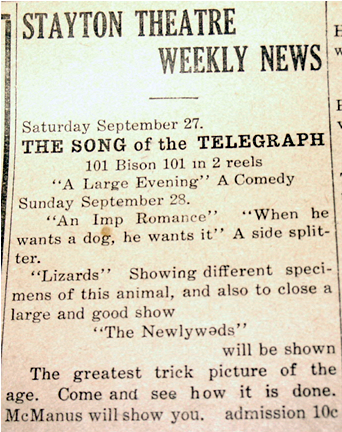 |
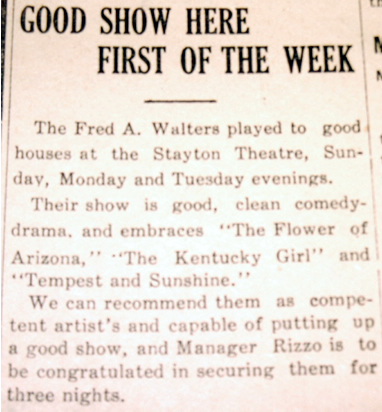 |
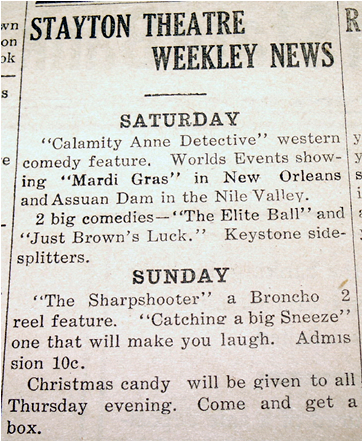 |
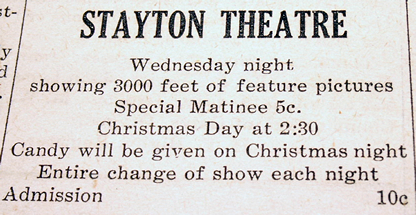 |
|
Bison 101:
Thomas Ince (1882-1924), known for inventing the studio system,
was the first studio executive who embraced the western in the teen
years. He arrived in California in 1911, where he produced detailed
scripts with new situations and characters for a vast number of
classic westerns. In 1912, his Bison Company production studios
(known as Inceville) purchased the Miller Brothers 101 Ranch and
the Wild West Show to use their props and performers for his assembly-line,
mass-produced films. By 1917, little-known John Ford was directing
westerns in California for Ince.
Universal Pictures, (or Universal Film Manufacturing Co), founded by Carl Laemmle in 1912; formed from a merger of Laemmle's own Independent Motion Picture Company (founded in 1909) with Bison 101, the U. S. production facilities of French studio Éclair, Nestor Film Co., and several other film companies; its first successes were W.C. Fields and Abbott and Costello comedies, the Flash Gordon serial, and Woody Woodpecker cartoons.
Thomas Harper Ince: Early Film Innovator
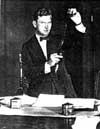 One
of the earliest trail-blazing industry's innovators was producer/director
Thomas Harper Ince, whose major claims to fame were the making of
crude westerns and the development of the "factory-studio system"
to mass produce films. After a short stint at Biograph as an actor
and director, he joined Carl Laemmle's Independent Moving Picture
(IMP) Company, and moved west in 1911. His New York Motion Picture
Co. and the Selig Polyscope Film Company of Chicago set up studios
near Los Angeles in Edendale [present-day Echo Park], initiating
the establishment of West Coast studio production.
One
of the earliest trail-blazing industry's innovators was producer/director
Thomas Harper Ince, whose major claims to fame were the making of
crude westerns and the development of the "factory-studio system"
to mass produce films. After a short stint at Biograph as an actor
and director, he joined Carl Laemmle's Independent Moving Picture
(IMP) Company, and moved west in 1911. His New York Motion Picture
Co. and the Selig Polyscope Film Company of Chicago set up studios
near Los Angeles in Edendale [present-day Echo Park], initiating
the establishment of West Coast studio production.
He supervised the Bison Company, a New York Motion Picture Company-owned studio/ranch that specialized in westerns and shot its films from detailed scripts (that broke down each scene into individual shots). The Bison Company became known as Inceville, after Ince bought about 20,000 acres of seacoast land in Santa Ynez Canyon and the surrounding hills. It became a prototype for Hollywood film studios of the future, with a studio head, directors, managers, production staff, and writers all working together under one organization (the unit system). He decentralized the process of movie production by enabling more than one film to be made at a time (on an assembly-line) to meet the increased demand from theaters, but his approach led to the studio's decline due to his formulaic, unfresh, systematized approach to production. [However, his methods continue into the present day within Hollywood's major studios.]
The studio reinvigorated the Western film genre. Ince's authentic-looking pictures were due to the fact that he hired real-life cowboys and Indians from the 101 Ranch as extras in his films. In 1914, he was responsible for launching the career of William S. Hart, an actor who starred in dozens of westerns until 1925. Filming ceased at the Inceville property around 1922 and the buildings burned to the ground in 1924. Ince mysteriously died one night in 1924, aboard William Randolph Hearst's yacht in the harbor of San Pedro (recreated in Peter Bogdanovich's The Cat's Meow (2002), speculating that he was shot by the host). Also, Orson Welles' Citizen Kane (1941) was based on William Randolph Hearst. Both movies a must see!
Extracted from FilmSite.org.